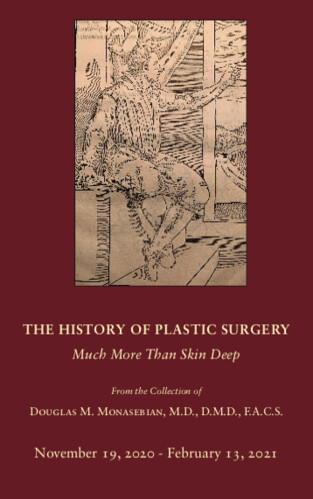"The History of Plastic Surgery: Much More Than Skin Deep" from the Collection of Douglas M. Monasebian, M.D., D.M.D., F.A.C.S.
I am not sure if every historian is a bibliophile, but I am quite sure that every bibliophile is a historian. To collect books not only requires one to understand the world as it was when the book was written but to appreciate the thoughts and ideas of the author as he went about his writings. As my personal collection grew, this became my driving force. I sought out books in plastic surgery that not only had significance in the progression of plastic surgery as a medical discipline but also possessed historical importance. Studies on facial expression, disease, and obesity were just as interesting to me as the first surgical descriptions of nasal reconstruction or cleft palate repair were.
While I have not always collected the aforementioned books, being a passionate collector has been a significant part of my life from a young age. At eight years old, I began collecting baseball cards; my collecting interest then shifted to Mad magazine through adolescence. I also recognized as a child that I wanted to become a surgeon. I was fascinated by science, loved working with my hands, but most importantly desired to be in a profession where I could help people. After graduating from dental school, I had a thirst for more knowledge in a different field of work and continued my education by going to medical school. I completed residencies in both oral and maxillofacial surgery and plastic surgery and then ventured into private practice.
As I grew comfortable in my private practice and had more discretionary time, I studied more on the history of my profession and learned that the fathers of modern-day plastic surgery were trained in the same fashion as myself. Their entry into this type of work was for different reasons; however, that made little difference to me. These individuals had medical and dental backgrounds and focused primarily on facial reconstructions that became increasingly prevalent because of the injuries soldiers suffered during World War I. This unique history enriched my experience and inspired me in my profession, which culminated in a desire to learn even more about the specialty. As with most surgeons, I can be obsessively compulsive and love to face different challenges. My new goal became to learn from everything I could get my hands on to uncover the multifaceted and fabulous history of plastic surgery. Unlike my past collecting endeavors, there is no simple checklist applicable here. One does not and cannot acquire sequential cards or magazine numbers and deem the collection to be complete. As any true collector knows, the deeper one gets into the collection, the further it spreads out. I saw myself seeking out not only books but photographs, autographed letters, instruments, and paper ephemera. All of it found a place in the collection and complemented the whole beautifully.
As medicine evolved throughout the last millennium, so did surgery. The barber surgeons of the 16th and 17th centuries were becoming more daring and sophisticated in their approaches to surgery. Although crude for the modern-day, some plastic surgery procedures have withstood the test of time and are still successfully employed today. For example, Tagliacozzi’s forehead flap can still be used, as can skin-grafting practices from the 1800s. The advent of antisepsis, anesthesia, and asepsis in the 19th century helped to make plastic surgery safer and more predictable. To the contrary, cleft lip repairs prior to the 18th century are now outdated.
I trust your exploration of this exhibit will allow you to share in the joy I have had while creating it. I also want to take this opportunity to thank my beloved parents, who continually inspired me to “do whatever I wanted to do in life, as long as it was to the best of my best ability.” And to my beautiful wife and children, thank you for your patience and support as my collection grew and diversified.
Douglas M. Monasebian, M.D., D.M.D., F.A.C.S.

